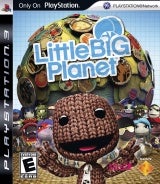LittleBigPlanet's success relies on its ability to be many things to many people, from a casual-friendly platformer to a toolset that enables fledgling designers to concoct their wildest dreams. Fortunately for PlayStation 3 owners, it performs those feats with remarkable aplomb. It's the first time in recent memory that gaming has seen a high-profile title that makes players work both sides of the curtain as both consumer and creator. Media Molecule's platformer is based on three ideas: Play, Create, and Share. Each of these elements works wonderfully in its own right, and that's key to why LittleBigPlanet is one of the year's best titles on any platform.
LittleBigPlanet puts you in control of a Sackperson. These cute, cloth creatures can be customized in a variety of ways with the items you collect from stage to stage. Controlling them is as simple as controlling any character in a side-scrolling platformer. Your core controls consist of jumping and grabbing; everything else expands from these two simple mechanics. You'll even have the ability to control their emotional expressions, from happy to fearful and from sad to angry, with a quick tap of the d-pad. It's all very easy to understand, but so much of the game's charm comes from the visual appeal of the characters. Your Sackperson exudes a special cuteness that's been missing from gaming since Katamari Damacy.
Play On, Playa
LittleBigPlanet's core game functions on a few levels. First, it's an introduction to the controls, a solid grounding in which proves useful when the game expands beyond Media Molecule's levels. Playing it also unlocks a wider range of materials to use in your own creations. The difficulty curve and approaches to puzzles and level design in these maps basically prime the player's mind to create their own levels. This is especially obvious in these first few days of release. It seems as though some of the more mediocre user-created levels might've been designed before playing Media Molecule's well-crafted stages.
Most importantly, each stage is simply fun. They're wonderfully diverse in aesthetic qualities, all themed around a specific geographic area. (Given how often some delve into odd but benign stereotypes, one must wonder how many times the London-based development team has visited Latin America.) From the English gardens that kick off the game to the beautiful Indian-themed stages of the later portions, each section is as dazzling to play as it is to see. The platforming gameplay is the best since Viewtiful Joe. Fortunately, there's enough to go around: LBP allows up to four people to jump on and play. In a few stages the game explicitly encourages multiplayer; some bonus items are unattainable without at least two people.
LBP's success also stems from its presentation. From the thread detail in your Sackperson to the richness of the environments it's a gorgeous game, through and through. The comparison to Katamari Damacy also applies to LBP's soundtrack. It's a mixture of music that range from the funky rock of Mexican band Kinky to DJ Krush's instrumental hip-hop beats, and they're just as well-placed as any of the visual motifs that permeate the experience.





 Outstanding!
Outstanding!


